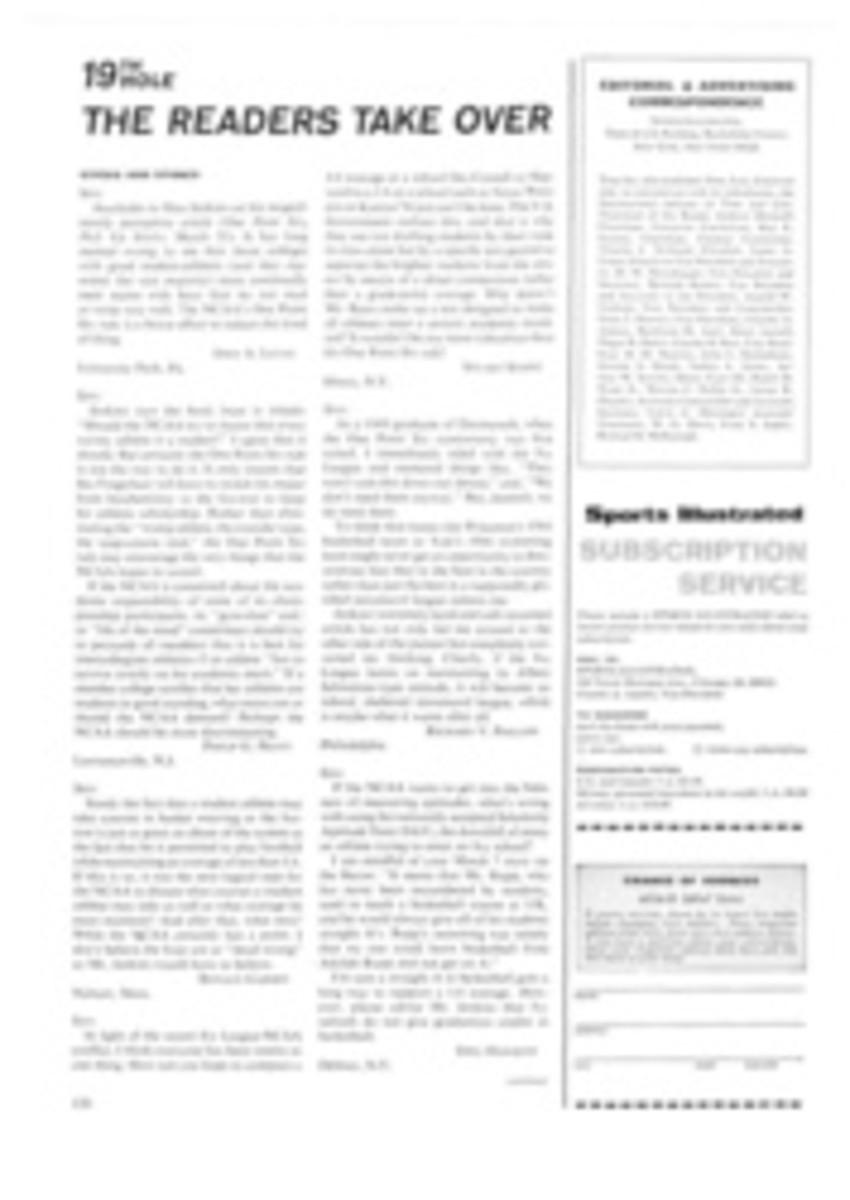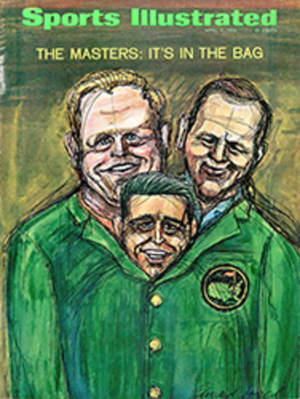
AT SEBRING: VICTORY AND DEATH
It was a curious and bloody race in Sebring, Fla. last week, but from it the current facts of sports car racing emerged, definitive and clear. Ford has arrived, Ferrari is making gloomy adieus and Chaparral is neither here nor there. Ford finished one, two and three in the 12-hour endurance race and would have finished one, two, three and four if Dan Gurney had not been operating under an obvious curse. On Friday, he set a new lap record of 2 minutes 54.6 seconds (107.2 mph) for the 5.2-mile course in a Ford Mark II prototype, which entitled him to the first starting position on the grid on Saturday. First starting position affords no real advantage in a 12-hour race, but the beginning foreshadowed the end. Gurney could not get the car started, and it moved out 63rd in a field of 64. After 11 hours and 59 minutes he was running first with a comfortable—under the circumstances—one-lap lead, when his engine failed on the back-stretch. This happens to Gurney. "It happened one time at Daytona," he recalled, without enthusiasm, after the race, "and it happened once at the Belgian Grand Prix."
Less than a quarter-mile from the finish line, Gurney elected to get out and push the car, and the car, having covered 228 laps, did cross the line. However, the rules of racing for points toward the Manufacturers' Trophy require that a car finish under its own power, and Gurney was disqualified in favor of the second-running car, a Ford Roadster XI driven by Ken Miles and Lloyd Ruby, which set official distance and average speed records of 228 laps and 98.631 mph. Had Gurney not pushed his car, he would have finished second.
Ceremonies in Victory Lane were untidy, with half the crowd crushed about Gurney and his disqualified car, and the other half attending to Miles and his functioning, victorious Ford XI. Jim Hall's two Texas-built Chaparrals had been out of the race for eight hours at that point, retired with a broken rear suspension and a bad oil leak. The two Ferrari contenders in the winner's class were just as finished, one with a failed transmission and the other burned up in the pits.
"We won't beat Ferrari consistently until this time next year," Ford's Carroll Shelby had said at Sebring in 1965. At the 24-hour Daytona Continental in February he defeated such Ferraris as there were—privately-owned and aging Ferraris—and judgment was essentially suspended until the Fords should run against new factory machines. At Sebring last week only one such car was entered, a Ferrari 330 P3, dubiously backed up by a much-used Ferrari 330 P2, driven by Pedro Rodriguez and Mario Andretti. However, since Enzo Ferrari had declared before the race that his limited operation had been steamrollered by the Ford Motor Company and he could no longer enter more than a single car in sports car races, one factory Ferrari would be the only opposition Ford was going to get.
The new Ferrari 330, driven by Englishman Michael Parkes and Californian Bob Bondurant, performed handsomely, giving no particular trouble until its last laps, when the gears proved intractable. On the 173rd lap, the transmission quit, and the car, with Bondurant at the wheel, gave up quietly near the track's hairpin turn. At that time the Ferrari was in second place.
The failure of the other contending Ferrari was a disaster. "It is a very tired car," said Coco Chinetti, the son of the car's owner, late in the afternoon. "It is coming in for its 25,000-mile checkup." Two hours later, the tired car's gear selector malfunctioned, and Andretti lost control before the course's Webster turn. Don Wester, in a Porsche Carrara 6, slammed into the spinning Ferrari and then into four spectators, all of whom were killed. Wester's injuries were minor. Unaware of what had happened, Andretti made it back to the pits, where his car was repaired. But there was oil or gasoline loose and when he turned on the ignition the car went up in flames. Andretti got out, but the Ferrari was finished and the cost had been high.
The spectators killed were Willis Edenfield and his two sons, and a friend, Mrs. Ford Heacock, a mother of three. Earlier in the day, Driver Bob McLean of Canada lost control entering the hairpin turn and died instantly when his Ford GT 40 struck a utility pole, turned end over end and burned upside down in a ditch. Thus, there were five deaths at a race that had had no fatalities for six years.
McLean's accident was a dreadful occurrence, but an acknowledged possibility in any automobile race. The deaths of Mrs. Heacock and the Edenfields, on the other hand, were considered by some to be the appalling ultimate result of the careless operation that the running of the Sebring race has become. Sebring seems to make little preparation for this event—which draws some 50,000 people to a town of 8,000—beyond raising its hotel rates. This casual approach might not be wholly without charm, but extended to the race itself it becomes hazardous. The pit areas on Saturday were crowded with little boys, bigger girls in tight stretch pants and old people with Brownie cameras, all identified and admitted by crew passes, press passes and photographers' passes, obviously distributed in small-town fashion by friends to friends.
Mechanics could barely make their way to the cars they were servicing, and drivers, when they were not in their cars on the track, had to hide out from the throng for fear of being smothered. Mr. Edenfield, his two boys and Mrs. Heacock were in possession of marshal's passes given them by Mrs. Heacock's husband (an owner of property at the racecourse). They died in an area where the viewing was splendid but which was closed to ordinary spectators as being dangerous.
Before the race there was an extraordinary, but justifiable, tension among all the principals. Even the ineffably assured Carroll Shelby, manager of what proved to be the top Fords, went around saying, "We're gonna win it," in a certain questioning way. Ford was known to have the speed, but there was legitimate doubt that the Ford brakes would stand up under the Ford weight on a course that is murderous on brakes. The Ferraris were lighter and more suited to the course, but most of Ferrari's eggs were in one basket. Finally, the Chaparrals could not be discounted, having won at Sebring last year (under special circumstances, in a heavy rain), but they had had to be almost totally rebuilt since last March to meet new racing specifications, and the one entered at Daytona had not performed well. Any one of the three makes, it could be argued, might take the race, and there were many who added the English Ford GT 40s and even the Chevrolet Sting Rays to the list.
By the time the race was four hours old Carroll Shelby was not worrying, even secretly, about anything. His brakes looked terrific. Gurney and Jerry Grant, in first place, and Miles and Ruby, in third, had the factory Ferrari between them and were playing games. "I can take one second a lap off the Ferrari," Miles said, with the smile of a happy hawk on his bladed, bony face. Ruby was out on the track, and Miles was sitting in the Ford trailer drinking tea. He was clean and fresh, being perhaps the only driver who changes clothes between driving stints.
At a table across the room England's Sir John Whitmore, in from his turn in a Ford GT, sat slumped in a chair, looking truly ill. The day was hot. "Several of them have come off the track looking like that," Miles observed (he already had volunteered that he himself was a lizard and loved heat). "Think of your ancestors, John," he said kindly, "marching across the Arabian desert in all that armor!" Sir John's expression indicated that thinking of his ancestors did not help.
A.J. Foyt came in. A.J. is a smiler—Shelby, Miles, Foyt and Ferrari's Bondurant are all long-distance smilers—and he smiled as he replied, "Oh, about 30," to a question as to where he was running. Foyt and Ronnie Bucknam were driving a Holman-Moody prepared Ford Mark II with an automatic transmission. The transmission was working beautifully, but the boys were boiling their brake fluid. If the boys settled down and stopped boiling the brake fluid, John Holman exquisitely implied, his cars probably could move up into quite respectable positions.
The Shelby-American Fords behaved well through the bulk of the race, but the Ferraris behaved well, too. Miles might have been taking the Parkes-Bondurant Ferrari for a second a lap, but after nine hours it was still running second and was giving few indications of coming trouble. When the trouble finally came at seven in the evening and the factory Ferrari went out, Shelby responded with a fiercely triumphant exclamation. "Got him!" he said, as if he had knocked out a machine-gun nest.
Dan Gurney's disqualification from a race he had led and so nearly won was a shock and a disappointment to the Ford troops, the Gurney fans and to Gurney himself. But for purposes of estimating the extent of the Ford victory, he and the Mark II must be counted in—and the victory was smashing. There is no question that a numerically stronger Ferrari team might have won or at least prevented so thorough a Ford sweep, but if Enzo Ferrari is in earnest about never again sending a full team to a sports car race, then, practically speaking, the field is now all Ford. And Sebring-Daytona Winners Miles and Ruby are only 47 and 38, respectively. This sort of thing could go on for years.
TWO PHOTOS
Winner Ken Miles, thoughtful during pit stop, repeated Daytona victory with co-driver Lloyd Ruby. Above: flames consume Bob McLean's Ford.

